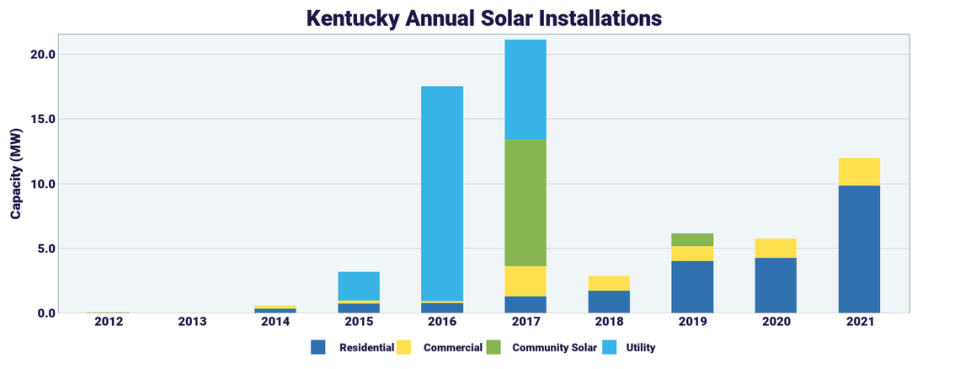Interested in switching to solar energy? Here’s what it could cost you in Kentucky
You may have seen the rosy advertisements on Facebook or YouTube. Promises from solar panel suppliers offering free equipment or the opportunity to “Get paid to go solar!”
But those ads don’t paint the full picture of the alternative energy industry.
“Solar is not going to take your electric bill down to zero, nor should it,” said Josh Bills, a certified energy manager with Mountain Association in Berea.
Bills also gets those ads. They often come from third-parties who are paid to generate sales leads for solar companies that sell, lease and loan panels to customers.
The ads promise low interest rates, two-year pauses on payments or “no money down” offers in hopes of closing a sale on a system. At least since the start of the pandemic, when lockdowns made door-to-door pitches impossible, these misleading ads have become the norm for a segment of the solar industry.
“My concern is that there’s going to be some shady characters that are trying to make a buck,” Bills said.
But interest in switching to solar is growing.
“We have installed more solar in 2022 as all of (the) prior years combined. We are on track to see same for 2023,” Bill said, paraphrasing what he’s hearing from Kentucky installers.
Data for annual installations in the commonwealth from the Solar Energy Industries Association show particular growth in residential solar system installs.

Citing state data, Bills also points out capacity for solar energy production has grown, rising from 15,481 kilowatts in 2019 to 40,300 kilowatts in 2021.
In addition, Solar Energy Solutions, an installation firm based in Lexington, now has more than 60 employees, up from 16 people just three years ago.
Kentucky’s energy profile report, an in-depth look at the state’s energy infrastructure, is also under review and due for an update this spring.
So how do you make the switch to solar the right way, ensuring you see the biggest possible return on your investment?
How to set realistic expectations for solar energy
Bills has worked on 100 renewable energy installations in Kentucky, Haiti and West Africa. The first step, the energy manager explains, is to realize this will be a long-term investment that generates savings over the course of a lifetime. Many of these photovoltaic, or PV, systems have 25-year warranties, he points out.
Given that, the question shifts to mitigating the investment costs, which aren’t insignificant.
Bills doesn’t recommend cutting corners on the install and advises against proceeding with a project that’s less than $5,000 to install. Installing a grid-tied solar system for less than $5,000 would make for a poor-return investment, Bills said.
There are many variables affect the overall cost of a system, including its size and how much the user wants to offset their home’s energy needs and backup capacity.
For large homes, including battery back-up capacity, the cost could range upwards of $30,000.
An average install cost is about $15,000 for a 5 or 7 kilowatt solar system.
Based on the average Kentucky home’s annual energy consumption, Bills estimated a potential savings of at least $20,000 over the course of a typical PV system’s life.
The recent solar incentives included in the federal Inflation Reduction Act make the energy savings even more attractive for people interested in solar. Those incentives, Bills said, provide 30 to 50% or more of install cost via tax credit.
“(I) can easily see all electric home residential projects with simple payback of less than 10 years then saving $2,000+ in electric bill savings each year over the following 20+ year life with $2,000 or $3,000 maintenance costs over that time,” Bills told the Herald-Leader.
A separate analysis by Forbes put the savings for a Kentucky home with 100% of its electrical needs covered by solar power at $1,705.05 annually.
The Forbes analysis assumed a start-up cost of $9,641, given the average cost for a 6 kilowatt system with a 26% federal tax credit applied. It put the number of years needed to break even on that investment at slightly more than five.
You also need to think about how to maximize and protect your investment, and your home’s overall energy efficiency is key, Bills said.
He doesn’t like seeing families get sold PV systems that support 100% of their energy use while their homes are still 50% less efficient than they could be. If you have a 15-year-old refrigerator in your home that’s costing you $2,000 of solar each year to run, you’d be much better off buying a low-cost, efficiency fridge that only sinks $400 of solar power, for example.
“We don’t want to see over-investment in solar when it can be done as a combined option” with an emphasis on energy efficiency, he said.
Avoiding scams: Who to buy from and what to look for
When you’re searching for a reputable PV installer, Bills said to look for one that will walk you through the process, a significant aspect of which will involve growing your understanding of how you use energy in your home.
When you are ready to look for an installer, searching through the directories of North American Board of Certified Energy Practitioners (NABCEP) is one good place to start, Bills said.
The Kentucky Solar Energy Society also has a similar directory of installers, along with a plain-English explanation of each of the NABCEP certifications. It also offers a consumer guide.
The Kentucky SES also has several resources for first-time buyers to help walk them through purchasing their first PV system.
Do you have a question about energy or a consumer issue for our service journalism team. We’d like to hear from you. Fill out our Know Your Kentucky form or email ask@herald-leader.com.

